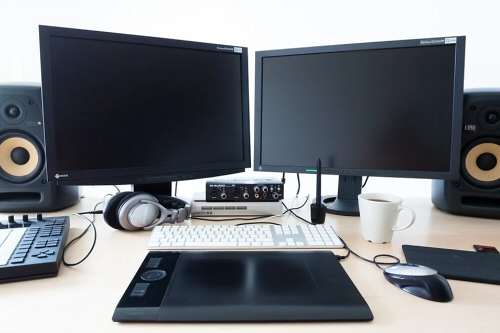Sound Advice to Help Tame Your Noisy Home Office
Fastco Works
An audio expert explains how the right work tools can boost efficiency while reducing stress – and shares some tips on making the most of our new work-from-home reality.
Theis Moerk knows a thing or two about noise. The vice president of product management, enterprise solutions at EPOS – a Copenhagen-based audio-tech company – oversees a line of premium tools designed for business. And he knows that users want one thing – for all incoming audio to come in both loud and clear.
With the COVID-19 pandemic making work-from-home a necessary condition – along with an increased reliance on phone and video conferencing amid the chaos of a bustling household – the right audio gear is more important than ever. Here, Moerk shares his thoughts on the importance of high-quality sound and how to overcome the challenges of working in your new dining-room office.
BAD AUDIO IS BAD FOR BUSINESS
Shortly before the pandemic disrupted businesses around the world, EPOS released the Understanding Sound Experiences survey – a wide-ranging report on how sound impacts an office. “We wanted to examine the significant consequences of poor-quality audio solutions on businesses and their employees,” Moerk says. The results confirmed what they suspected: Ninety-five percent of respondents said their concentration and efficiency suffered due to deficient sound. And as Moerk points out, that affects the bottom line. “The resulting confusion created by poor audio, which includes miscommunication, misunderstanding, and misinterpretation, leads to nearly 30 minutes of wasted time every week.”
GOOD AUDIO MEANS HAPPIER WORKERS
Having even more of an impact than the irrecoverable man-hours is the added stress and frustration of having to rely on less-than-optimum gear. “In our survey, 35 percent of workers reported frustration or annoyance, while others said the problems lead to diminished confidence or embarrassment,” Moerk says. “Think about the last time you had to say, ‘Sorry, I didn’t catch that.’”

IDENTIFYING AUDITORY PAIN POINTS
Five hours and 18 minutes. According to the EPOS report, that’s the average amount of time office workers spent on sound-dependent interactions every day. It’s hardly surprising that these employees identified a number of “pain points” that crept into these tasks. “We found the two most widely described complaints were the poor sound quality from inferior audio gear and the noise-related disruptions from loud colleagues or the din of a busy home,” Moerk reports.”
THE MOST IMPORTANT FIX: A GOOD HEADSET
The right tools can make all the difference in the world. “Nearly 80 percent of decision makers who responded to the EPOS survey agreed that high-quality audio gear can significantly mitigate these pain points,” Moerk says, “while at the same time eliminating distracting noise that can negatively impact concentration and even mental health.” In other words: A good headset is a smart investment.
WHAT TO LOOK FOR IN A HEADSET
Active noise cancellation – the decades-old technology that all but eliminates unwanted sounds from reaching your ears – should be a basic requirement, though hardly the only one. “There are other important parameters we also focus on,” Moerk says. “These include: battery life, comfort (as headsets are often worn for hours at a time), algorithms that improve speech intelligibility (which work hand in hand with noise cancellation), the quality of the microphone (which effects how you sound on the other end), and wireless security technologies for workers who must discuss sensitive information.”
NOT YOUR FATHER’S ACTIVE NOISE CANCELLATION
For many, “active noise cancellation” (ANC) still evokes a system that focuses on eliminating an airplane’s cabin noise. But ANC is now vastly more robust and capable, utilizing tiny microphones that measure unwanted noises and instantly generating waveforms that ‘cancel’ them out before they even reach your ear. “The latest advances are specifically designed to adjust to the noise challenges of open-office environments as well as typical households,” Moerk says.
WHAT’S THE RIGHT HEADSET FOR YOU?
For the most basic home-office needs, Moerk (naturally) suggests the models in EPOS’s Enterprise Solutions line – the ADAPT 400 and ADAPT 500 – which come with the company’s proprietary Hybrid ANC technology. A step up is the ADAPT 600 series, which utilizes what they call Hybrid Adaptive ANC. “It uses 4 microphones to constantly monitor your background environment – home, office, or even outdoors – to give a seamless and precise level of noise cancellation,” he says. For the most demanding audio challenges, Moerk recommends the ADAPT 660 Series, which represents the first EPOS product to implement artificial intelligence. “It uses machine-learning-developed algorithms,” he explains, “to optimize the sound quality of your voice in almost any audio environment.”
LESSONS LEARNED WHILE WORKING FROM HOME
“Even as workplaces began moving toward the open-plan layouts over the past decade, audio engineers understood that they would need to address a set of noise sources – from colleagues, office equipment, and even foot traffic,” recounts Moerk, who says he now has a better understanding of looming challenges based both on the EPOS study and his weeks of telecommuting. “Of course, working from home adds a new set; intrusive noises are hardly confined to office environments. And as sound-dependent interactions will increase in this new reality, it’s important that we offer solutions that not only reduce pain points and boost efficiency, but also manage stress in the high-activity zones that are our home offices.”








